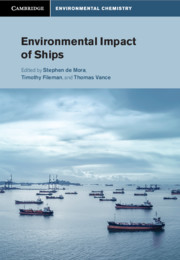Book contents
- Environmental Impact of Ships
- Cambridge Environmental Chemistry Series
- Environmental Impact of Ships
- Copyright page
- Contents
- Contributors
- Preface
- 1 Shipping, Ships and the Environment
- 2 Atmospheric Emissions from Ships
- 3 Oil Pollution from Operations and Shipwrecks
- 4 Waste and Sewage
- 5 Ballast Water
- 6 Biocides from Marine Coatings
- 7 Invasive Species
- 8 Physical Effects of Ships on the Environment
- 9 Ship Noise
- 10 Vessel Strikes and North Atlantic Right Whales
- 11 Nuclear-Powered Vessels
- 12 Environmental Impacts of Shipbreaking
- 13 International Legislative Framework
- 14 Shipping Industry’s Perspective
- 15 Environmental Impacts of Shipping
- Index
- References
3 - Oil Pollution from Operations and Shipwrecks
Published online by Cambridge University Press: 22 January 2021
- Environmental Impact of Ships
- Cambridge Environmental Chemistry Series
- Environmental Impact of Ships
- Copyright page
- Contents
- Contributors
- Preface
- 1 Shipping, Ships and the Environment
- 2 Atmospheric Emissions from Ships
- 3 Oil Pollution from Operations and Shipwrecks
- 4 Waste and Sewage
- 5 Ballast Water
- 6 Biocides from Marine Coatings
- 7 Invasive Species
- 8 Physical Effects of Ships on the Environment
- 9 Ship Noise
- 10 Vessel Strikes and North Atlantic Right Whales
- 11 Nuclear-Powered Vessels
- 12 Environmental Impacts of Shipbreaking
- 13 International Legislative Framework
- 14 Shipping Industry’s Perspective
- 15 Environmental Impacts of Shipping
- Index
- References
Summary
Ships are essential facilitators of modern economies – they are by far the most cost-effective mode of long-distance transport for both finished goods and raw materials, and over 90 percent of world trade is carried by sea (IMO, 2017a). There were more than 50,000 ships in the world's merchant fleets in 2015. Bulk carriers – carrying solids such as coal and grains – accounted for about a fifth of the fleet, with a combined capacity of around 705 million tons deadweight. General cargo carriers numbered about 17,000, crude oil tankers about 7000 and container ships about 5000 (Statista, 2018). The amounts moved are staggering; for example, the International Tanker Owners Pollution Federation (ITOPF, 2018) reported that seaborne oil trade has averaged 100 trillion barrel-miles per year since 2000. Financial efficiency pushes for ever-larger vessels, and concomitantly ever-larger canals (Chen et al., 2016) and dock facilities (Mongelluzzo, 2016).
- Type
- Chapter
- Information
- Environmental Impact of Ships , pp. 56 - 74Publisher: Cambridge University PressPrint publication year: 2020

